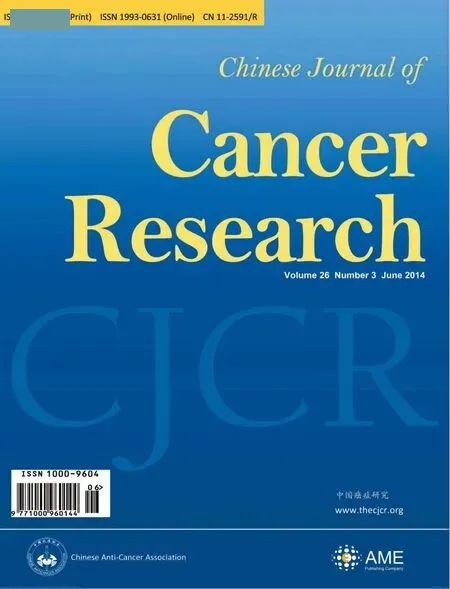The unique phenotypes of adenocarcinoma of the esophagogastric junction in China
Min Feng,Wenxian Guan
Department of General Surgery,Nanjing Drum Tower Hospital,the Affiliated Hospital of Nanjing University Medical School,Nanjing 210008,China
Adenocarcinoma of the esophagogastric junction (AEG)was proposed as a distinct disease for its rapidly increasing incidence.However,most studies of AEG were based primarily on the results of western patients and the studies on Chinese patients were deficient.Recently,some retrospective studies on AEG patients from our hospital show distinct clinical and pathological features compared with American patients (1-3).In this editorial,we will focus on the unique phenotypes of Chinese AEG patients based on our studies and other reports.
The same as in Western Countries,AEG in China,was considered as the adenocarcinoma in the region of esophagogastric junction (EGJ).However,the definition of EGJ was still unclear.Anatomically,it represented the region where the tubular esophagus joined the stomach.Endoscopically,the EGJ was defined as the distal ends of esophageal squamous mucosa that met the proximal ends of gastric columnar mucosal folds.For esophageal squamous epithelium might be replaced by columnar epithelium especially in patients with hiatal hernias,gastrooesophageal reflux disease (GERD) or Barrett oesophagus (BO),the squamocolumnar junction was not a reliable landmark of the EGJ.Recently,based on anatomical EGJ,AEG was classified into three types,and adenocarcinoma of distal esophagus was one import type in western countries(3,4).However,our previous studies demonstrated that the adenocarcinoma of distal esophagus was rare in Nanjing and another study indicated that the incidence of esophageal adenocarcinoma in Hong Kong was decreased in last two decades (1,2,5).These results suggested that there be distinct features of Chinese AEG.Our further study including 142 consecutive resection cases show that AEG in Chinese patients was often accompanied by chronic gastritis,H.pylori infection,intestinal metaplasia,or gastric dysplasia,rather than GERD and BO,as in western patients.Meanwhile,we found that staging AEG as gastric cancer improved prognostication,while staging this disease as esophageal cancer resulted in more confusion.This result was in line with other reports on Chinese patients (6,7).These data indicated that Chinese AEG might be developed from proximal gastric cancer associated with chronic gastritis or intestinal metaplasia,rather than BO.
In addition,our studies also found that AEG in Chinese patients had heterogeneous histology and often included squamous,neuroendocrine and pancreatic acinar cells compared with adenocarcinoma arising in columnar metaplasia of the oesophagus in American patients.These histological features were also found in Japanese patients (8).Moreover,compared with Western patients,Chinese patients were younger and had larger tumor size,more frequent involvement of the proximal stomach,higher pathological stage and more frequent lymph node metastasis.However,the overall survival rates among American and Chinese patients were similar.These results suggested that despite the fact that the Chinese patients had a significantly higher proportion of late stage tumors at the time of diagnosis,the overall survival rate of Chinese patients was better relatively (1).
In conclusions,compared with Western countries,Chinese AEG was association with H.pylori-related gastritis or dysplasia rather than BO.The lymph node metastases were similar to gastric cancer and staging Chinese AEG by gastric staging scheme was more accurate than by esophageal staging scheme.Furthermore,Chinese patients commonly had higher pathological stage,more frequent lymph node metastasis and larger tumor size at the time of diagnosis.However,the overall survival rate for Chinese patients was similar to western patients.Although,we have not yet understood the differences of AEG between China and Western Countries totally,the unique phenotypes of Chinese patients should attract our more attention for more suitable treatment in future.
Acknowledgements
Disclosure:The authors declare no conflict of interest.
1.Huang Q,Fan X,Agoston AT,et al.Comparison of gastro-oesophageal junction carcinomas in Chinese versus American patients.Histopathology 2011;59:188-97.
2.Huang Q.Definition of the esophagogastric junction: a critical mini review.Arch Pathol Lab Med 2011;135:384-9.
3.Huang Q,Shi J,Feng A,et al.Gastric cardiac carcinomas involving the esophagus are more adequately staged as gastric cancers by the 7th edition of the American Joint Commission on Cancer Staging System.Mod Pathol 2011;24:138-46.
4.Baldus SE.Histopathologic classification of adenocarcinoma of the esophagogastric junction.Recent Results Cancer Res 2010;182:29-38.
5.Yee YK,Cheung TK,Chan AO,et al.Decreasing trend of esophageal adenocarcinoma in Hong Kong.Cancer Epidemiol Biomarkers Prev 2007;16:2637-40.
6.Kamangar F,Qiao YL,Blaser MJ,et al.Helicobacter pylori and oesophageal and gastric cancers in a prospective study in China.Br J Cancer 2007;96:172-6.
7.Zhang YF,Shi J,Yu HP,et al.Factors predicting survival in patients with proximal gastric carcinoma involving the esophagus.World J Gastroenterol 2012;18:3602-9.
8.Hasegawa S,Yoshikawa T,Cho H,et al.Is adenocarcinoma of the esophagogastric junction different between Japan and western countries? The incidence and clinicopathological features at a Japanese high-volume cancer center.World J Surg 2009;33:95-103.
 Chinese Journal of Cancer Research2014年3期
Chinese Journal of Cancer Research2014年3期
- Chinese Journal of Cancer Research的其它文章
- Laparoscopic approach for hepatocellular carcinoma: where is the limit?
- Comments to young surgeons concerning laparoscopic spleenpreserving D2 lymph node dissection for advanced gastric cancer on the upper body
- Laparoscopic resection for hepatocellular carcinoma: comparison between Middle Eastern and Western experience
- Laparoscopic resection for hepatocellular carcinoma: eastern and western experiences
- Adenocarcinoma of esophagogastric junction: controversial classification, surgical management, and clinicopathology
- Laparoscopic liver resection: western versus eastern experience
